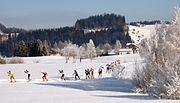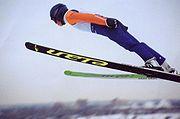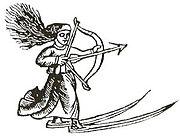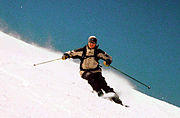Define some of the language that us skiers use. example... dope: not the drug but something really awesome and fun and bad ass.
Snow skiing is a group of sports using skis as primary equipment. Skis are used in conjunction with boots that connect to the ski with use of a binding. Skiing can be grouped into two general categories. Nordic skiing is the oldest and includes sport that evolved from skiing as done in Scandinavia. Nordic style bindings attach at the toes of the skier's boots but not at the heels. Alpine skiing includes sports that evolved from skiing as done in the Alps. Alpine bindings attach at both the toe and the heel of the skier's boots. As with many disciplines, such as Telemark skiing, there is some crossover. However, binding style and history tend to dictate whether a style is considered Nordic or Alpine. Therefore, in view of its lack of a locking heel, and its roots in Telemark, Norway, Telemark is generally considered a Nordic discipline.
- 1 History
- 2 Types of skiing
- 3 Skiing competition
- 4 Skiing for people with disabilities
- 5 Risks of Injuries while skiing
- 6 Related sports
- 7 See also
- 8 References
- 9 External links
Pre-historic Nordic people and Samis invented skiing to assist hunting, military maneuvers, and as a practical transportation for themselves. The oldest and most accurately documented evidence of skiing origins is found in modern day Norway and Sweden. The earliest primitive carvings circa 5000 B.C. depict a skier with one pole, located in Rødøy, an island in the Nordland region of Norway. The first primitive ski was found in a peat bog in Hoting, Sweden which dates back to 2500 or 4500 B.C.[1][2] Joel Berglund reported in 2004 the discovery of a primitive ski, or "85cm long piece of wood", carbon tested by researchers in 1997 while excavating a Norse settlement near Nanortalik, Greenland. The primitive ski dated back to 1010, and is thought to be Greenland's oldest ski brought by Norsemen circa 980 A.D.[3]
Other accounts of early Nordic skiing are found with two modern cross-country endurance races in Norway and Sweden. These ski races were inspired by famous historic accounts of early medieval skiing in their respective countries. The oldest account involves the famous story from 1206 A.D. of the Birkebeiners during a civil war in medieval Norway. Considered the underdog, the Birkebeiners were at war against a rival faction known as the baglers. Following the death of the Birkenbeiner chief, the baglers feared a rival in his young son Haakon Haakonsson. To protect him, two of the most skillful Birkenbeiner skiers, with toddler in tow, skied through treacherous conditions over the mountains to safety in Lillehammer. Since 1932, Norway's annual Birkebeinerrennet runs a 54 km cross-country ski race that pays tribute to this historic account.[4][5] Since 1922, Sweden has run their own ski marathon known as the Vasaloppet. With its longest race at 90 km and finishing in Mora, Sweden, it is known as the world's longest cross-country ski race. This endurance race commemorates the memory of "freedom fighter" Gustav Vasa and subsequently Swedish independence. Pursued by the Danes in 1520 A.D. (under order from King Christian of Denmark who controlled Sweden at the time), Gustav Vasa attempted to raise an army against the Danes but was forced to flee by skis northwest toward Norway. Tracked down by Mora's two best skiers, Gustav returned with them to Mora and lead an uprising that eventually overthrew Danish rule.[6]
Skiing is also recorded in early literature. Icelandic saga author (circa 1200) Snorre Sturlason wrote of Ull "God of Skiing" and Skade "Goddess of Skiing and Hunting" in Norse mythology. One of the world's oldest references to skiing is by Egil Skallagrimsson’s "950 AD saga describing King Haakon Adalsteinsfostre the Good’s practice of sending his tax collectors out on skis".[7] Another one of the oldest written accounts of skiing is by Swedish writer Olaus Magnus in his writings A Description of the Northern Peoples in 1555. His accounts record early primitive skiers (presumably the Sami people) and their "climbing skins" in Scricfinnia, a country or region at the top of modern day Norway.[8] [9] Sometime around 1800 A.D. Danish traveler Father Knut Leed made reference in Geographie to Norwegian kids "skiing just for the fun of it, being able to pick up a hat dropped on the slope while going at full speed."[10]
The word "ski" itself is one of a handful of words Norway has exported to the international community. It comes from the Old Norse word "skio" which means split piece of wood or firewood.[11] [12] Previously, English speakers considered skiing to be a type of snowshoeing. In regions where loose snow dominates, the indigenous population developed snowshoes that did not slide across the snow, unlike skis. Today's forms of skiing are the modern extensions of ancient Nordic skiing. Whether it be the Nordic forms of Cross-country skiing (a form of Telemark skiing) and Telemark skiing, Ski mountaineering or Alpine skiing, modern forms of skiing share common threads of origin from the Telemark region in Norway led by Norwegian ski innovator Sondre Norheim.[10]
Norwegian Sondre Norheim is known as the "father of modern skiing" (the originator of skiing as recreation and sport).[13] From the Telemark district of Morgedal, Norway, which is also known as the "cradle of skiing", Norheim created the design templates from which all forms of modern skiing are derived. In 1850, woodcarvers from the Telemark region introduced lighter, thinner, cambered skis.[14] These developments were accompanied by Norheim's creation of stiff bindings by fully securing the heel with a strong yet flexible strap made from birch roots. This new binding system enabled the skier to swing, jump and maneuver turns while skiing down hills.[10] These were known as "Osier" bindings.[15] [16] Morten Lund writes, in his piece outlining the development of Alpine skiing, that "Telemark skiing marked the transition to dynamic control, changing the angle of the ski bottom on the snow and changing the direction of the ski to the line of descent—the basis of technique even today", thus the necessity for Norheim's heel binding invention. And as a result, came the "flowering of the world’s first "freestyle" contests—climbing, running, making turns for the heck of it and flying off natural bumps on unprepared snow."[10]
In 1868, with a couple fellow skiers, Norheim attended the "second annual Centralforeningen (Central Ski Association) open ski competition whose object was to demonstrate skill at descending a particular slope in the city."[10] At the competition, Norheim demonstrated groundbreaking techniques that set the ideal benchmarks for skiing in Norway and the European Continent: the arc-like sweep of the "telemark turn" along with the skidded "stem" stop turn (commonly known as the "parallel" stop turn), which was initially known as the "Christiania" turn (original name for modern day Oslo).[10] [17] The "Christiania" came to be known simply as the "Christi" turn with the formalization of ski rules in 1901.[18] [10] Both turns, which originated in Telemark, mark the distinction between Telemark and Alpine skiing.[13]
Then in 1870, Norheim introduced his adaptive design of the Telemark or "narrow-waisted" ski - "the forerunner of the sidecuts used on skis today." Skis were narrowed, shortened and sides curved inwards.[10] These refinements greatly facilitated easier ski turns and set "the standard for ski design over the next century."[10] By the 1880s, as demand for Norwegian skis increased, changes led to the development of the first laminated skis which began to appear in 1881. These new fangled "hand-crafted" skis were constructed "with an ash sole and pine top" and first exported to Sweden in 1882.[10] Also in 1882, the first hickory skis appeared in Norway providing for a thinner more flexible ski. Ski development was continued by Norwegian H.M. Christiansen who constructed the first two-layer laminated ski in 1893, followed by fellow Norwegian Bjørn Ullevoldsaeter's patented three-layer laminated ski. (Incidentally, this style was also independently developed by George Aaland in Seattle.)[19] [20]
Collectively, these innovative designs and techniques laid the foundation for all forms of modern skiing and further developments, including one established form of skiing called Slalom by Norheim and his contemporaries in the Telemark region.[11] [21] [22] Slalom, or "slalåm" in Norwegian dialect, is a Norwegian word originating from Morgedal, Norway. "Sla" refers to slope, hill, or smooth surface while "låm" means "track down the slope".[11]
The skiing techniques of 19th century Morgedal known as Telemark skiing or "telemarking" underwent a revival in the 1970s. This revival of Telemark skiing has been attributed by author Halvor Kleppen to five American skiers from Colorado: Doug Buzzell, Craig Hall, Greg Dalbey, Jack Marcial and Rick Borkovec, who were collectively inspired by Norwegian ski phenomenon and Olympic champion Stein Ericksen and his book Come Ski With Me.[23]
Whereas Sondre Norheim had initially invented secure heeled bindings using water-soaked, flexible birch roots[24], the next significant development of binding came in 1894 from Fritz Huitfeldt who invented a binding with a secure toe iron which allowed the heel to move freely. This became the standard industry binding through the 1930s.[1] [16]
[Section to possibly be developed here on the more significant binding developments: e.g. 1933 Adolph Attenhofer - "complete fixed heel all-metal binding" and 1939 Hjalmar Hvam Saf-Ski binding] [17] [16]
[Section to be developed here on the precursors to Alpine Racing: "long board competition" and/or what was known as "snowshoe" racing (not First Nation snowshoes) and British Continental skiing approach.][10] [25] [26]
Retired Austrian school teacher Mathias Zdarsky, like many others at the time (including famed Norwegian explorer Roald Amundsen who became the first man to "ski" to the South Pole in 1911), was intrigued by world-renowned Norwegian explorer and Telemark skier Fridtjof Nansen, and his "high-risk expedition" accounts, in the 1890 German translation of Nansen's book On Skis Across Greenland.[10] Inspired by Nansen's skiing exploits, Zdarsky took up the sport during his retirement by importing Norwegian skis and teaching himself to ski. Incorporating ski techniques from Norway, he developed a ski technique system, known as the "Lilienfeld Method", which he outlined in his 1896 book Lillienfeld Skilaufer Technik (originally published as Lilienfelder Ski lauf-Technik). [21] [1] [27] His key development, which led to enthusiastic embrace of skiing in the Alps, was the "stem" technique, or what is commonly known is skiing as the "snowplow" technique. This new technique enabled beginners to experience the slopes in a "slow, and controlled manner", beyond the more sophisticated and complicated Norwegian Telemark and Christiania techniques, which limited the slopes to more advanced and skillful skiers. By 1896, he was teaching his new methods to large groups of "stem skiers" in Austria. [10] [28]
[Section to be developed here Circa 1910-20ish on the "transition from ski mountaineering into alpine skiing" or racing initiated by the British and Arnold Lunn who took Norway's concept of Slalom skiing and created modern day downhill or Slalom racing.] [10] [17]
In 1908, expanding on the developments of this fellow countryman Zdarsky, a young Austrian ski guide by the name of Johannes Schneider entered the scene. With respect to skiing, Johannes (also known as Hannes) is to Austrians as Sondre Norheim and Fridtjof Nansen is to Norwegians. By the 1920s, he had worked to refine Sondre Norheim's "Christiania" stem christi turn, along with fellow countryman Mathias Zdarsky's "stem" or "snowplow" technique. He used these Norwegian and Austrian techniques to develop a logical system of ski instruction, a system which began with the easiest snowplow technique, then progressing through to more difficult ski skills. This system formed the basis for Schneider's formalized Arlberg technique, which is named for his home region, and subsequently set a foundation for professional ski instruction. [1] [10] This system also incorporated a set of ethical standards to the profession of teaching. With this, the Arlberg technique spread and helped make skiing a popular recreational activity.[21]
The biomechanical principles of alpine skiing were described in 1985 by Georg Kassat, professor at Münster University
[edit] Types of skiingMany different types of skiing are popular, especially in colder climates, and many types of competitive skiing events are recognized by the International Olympic Committee (IOC), the International Ski Federation (FIS), and other sporting organizations, such as the U.S. Ski and Snowboard Association in America. Skiing is most visible to the public during the Winter Olympic Games where it is a major sport.
In skiing's traditional core regions in the snowy parts of Scandinavia, as well as in places such as Alaska, both recreational and competitive skiing is as likely to refer to the cross-country variants as to the internationally downhill variants.
Skiing techniques are difficult to master, and accordingly there are ski schools that teach everything from the basics of turning and stopping safely to more advanced carving, racing, mogul or "bump" skiing and newer freestyle techniques. There are two primary types of downhill skiing -- "telemark" and "alpine."
For beginning skiers learning under a trained instructor, skiing speeds are low, the terrain is not steep and is often well-manicured, and the risks are relatively low. For extreme skiers, testing their expert abilities against ever more challenging terrain, the risks may be much higher.
Alpine Freestyle: This kind of skiing employs the use of aerial acrobatics and balance, balance being necessary for rails. The use of rails is known as grinding or jibbing. Alpine freestyle was pioneered by Stein Eriksen in 1962. It developed in the 1970s into a style called Hotdogging. More recently, Alpine freestyle has evolved into the current style called Freeskiing or freestyle skiing, a new style of skiing that started in the late 1990s, specifically 1998 when the Salomon "Teneighty" twin-tip ski (the first successfully marketed twin-tip ski) flew off the shelves, changing the ski industry and culture forever. The very first twin-tip ski ever made remains the "Olin Mark IV comp". In this type of skiing, skiers use jumps (also called kickers or launches) or rails to do aerial tricks. These tricks are reinvented and progressed in technique and style every day.[29]
Free skiing or New School: The type of skiing with which tricks are usually associated. The skis normally used are twin-tips and are designed to land tricks backwards as easily as forwards as well as braces worn on the back of the boots to avoid shock-injuries. A free-skier can be seen taking a helicopter to the top of mountains, mainly to avoid the pistes, and would find natural jumps, moguls and obstacles such as fallen trees to perform their hallmark tricks on. Tricks are generally spins and flips, that can be conjoined with a grabbing of the ski to improve the image of the trick as well as grinds. This type of skiing can be very dangerous due to terrain and remoteness, so the majority of free-skiers are professionals.
Backcountry skiing: Also see ski touring.
Nordic Skiing: Also called Cross-country skiing or Cross-country racing. Takes its name from a type of ski race that is one third up, one third down, and one third flat. The name distinguishes it from other types of ski races and competition such as downhill racing, slalom racing, and Nordic jumping. Cross-country races can be either freestyle or classic. In freestyle racing, any technique is allowed as long as it is human powered and on skis. In a classic race, skating techniques are prohibited. World wide, Nordic skiing may be the most popular form of skiing since it does not require a specialty ski area. Typically after donning appropriate clothing, the skier goes outside and skis in a local park or even on a snowy street. Nordic skiing is the oldest form of skiing and was developed in Scandinavia as a way of travelling in the winter.
Dry Slope Skiing[1]: This is skiing on artificial or dry snow, or dirt. Dry slope skiing is a year-round sport in countries like the UK where the snow cover is insufficient for traditional skiing. There is a thriving race programme on British slopes. [2].
Adaptive Skiing is skiing done by individuals with physical disabilities. Adaptations to standard ski equipment or accompaniment by a non-disabled guide has enabled individuals with amputations, spinal injuries, TBI, deafness and visual impairments to ski, and in some cases, even race.
Kite skiing and para-skiing is skiing done while being pulled or carried by a parasail, hang glider, or kite.
Military Skiing: In addition to its role in recreation and sport, skiing is also used as a means of transport by the military, and many armies train troops for ski warfare. Ski troops played a key role in retaining Finnish independence from Russia during the Winter War, and from Germany during the Lapland War, although the use of ski troops was recorded by the Danish historian Saxo Grammaticus in the 13th century. The sport of Biathlon was developed from military skiing patrols.
Nordic Jumping: Also called ski-flying and ski jumping. A competition in which skiers slide down a ramp called a jump and attempt to go the furthest before landing on the ground. This is done with Nordic style skis, meaning that the heels of boot and binding are detached from the ski. The skis are much longer and wider than other types of skis and jumping is typically done without ski-poles.
Randonnée: See also ski touring, backcountry skiing.
Ski jøring Ski jøring, also called Euro-style mushing, is skiing while being pulled by an animal(s), typically dogs or horses, or by snowmachine.
Telemark skiing: See also ski touring.
The venue, speed and technical difficulty associated with the sport can lead to collisions, accidents, hypothermia and other injury or illness, occasionally including death. Regional Ski Patrol organizations, such as the National Ski Patrol in the U.S., exist as a voluntary organization to provide guidance, help, medical assistance and emergency rescue to those in need of it.
[edit] Skiing competitionSkiing competition is organized by the International Ski Federation, which is responsible for development of rules and scheduling of competitions worldwide in alpine skiing, cross country skiing, freestyle skiing, Nordic combined and ski jumping. Competition is managed in each country by its national association. The U.S. Ski and Snowboard Association is responsible for competitive skiing in America.
[edit] Skiing for people with disabilitiesSkiing for people with disabilities became popular after World War II with the return of injured veterans.[citation needed] It is both a recreational pastime and a competitive sport open to those with any manner of cognitive and/or physical disabilities. Adaptations include the use of outriggers, ski tip retention devices, sit-skis like monoskis and bi-skis, brightly colored guide bibs, ski guides, and inter-skier communication systems or audible clues for blind skiers.
Recreational skiing programs for people with disabilities exist at mountains across the globe.
Currently the International Paralympic Committee (IPC) and the International Ski Federation (FIS) sanction a number of regional, national, and international disabled skiing events, most notably a World Cup circuit, a Disabled Alpine Skiing World Championships, and the Paralympic Winter Games. One of the strongest disabled programs is the U.S. Disabled Ski Team, organized by the U.S. Ski and Snowboard Association and the U.S. Ski Team.
Inexperienced skiiers or seasoned veterans are prone to injuries that range from minor to fatal. Minor injuries can be when you fall down or if you break bones. Fatal injuries include hitting a tree on impact, for it could cause brain damage, brain blood vessels could burst, or even worse, death. Famous people and celebrities who succumbed to skiing accidents are Michael LeMoyne Kennedy (1958-97), Sonny Bono (1935-1998), and most recently, Natasha Richardson (1963-2009).
[edit] Related sports [edit] See also- List of skiing topics
- Skiing and snowboarding on film and video
- Skiing is so popular in today's life, that it has been the main motif for many collectors' coins and medals. One of the most recent one is the Austrian 5 euro 100 Years of Skiing commemorative coin, minted in January 26, 2005. The design shows a snow crystal symbolizing winter sport with a downhill skier racing through the crystal.
- ^ a b c d Chronology timeline, North American ski mountaineering backcountry skiing
- ^ Aspenhistory.Org
- ^ IOL: Wiping the snow off Greenland's oldest ski
- ^ Birkebeiner.no
- ^ Birkebeiner.no
- ^ Vasaloppet.se > Vasaloppet bakåt i tiden
- ^ Aspenhistory.Org
- ^ Description of Scricfinnia, Olaus Magnus, early backcountry skiing
- ^ The Northern Lights Route - Olaus Magnus
- ^ a b c d e f g h i j k l m n o Skiing Heritage - Alpine History
- ^ a b c The cradle of skiing (Norway - the official site in the United States)
- ^ Skiing and the Creation of a Norwegian Identity (Norway - the official site in the United States)
- ^ a b Sondre in the History of Skiing
- ^ Ski History Dates
- ^ Skiing pioneer featured in new book (Norway - the official site in the United States)
- ^ a b c Aspenhistory.Org
- ^ a b c Ski History Dates
- ^ Skis - Bindings - Telemark Turn - Christiania Turn - Slalom
- ^ Ski History Dates
- ^ Aspenhistory.Org
- ^ a b c Ski History Dates
- ^ Aspenhistory.Org
- ^ Alpenglow Ski History - Halvor Kleppen - Telemark Skiing, Norway's Gift to the World
- ^ Skiing pioneer featured in new book (Norway - the official site in the United States)
- ^ Aspenhistory.Org
- ^ Aspenhistory.Org
- ^ Aspenhistory.Org
- ^ Aspenhistory.Org
- ^ Taylor, Derek. "Xspeak: Skiing". ESPN Internet Ventures. http://espn.go.com/extreme/winterx00/s/glossaryskiing.html. Retrieved on 2007-04-12.
 Wikimedia Commons has media related to: Skiing
Wikimedia Commons has media related to: Skiing
- Online Skiing Magazine: Articles, Photos, Videos, Gear Reviews, Backcountry Ski Guide
- Sports: Winter Sports: Skiing Directory of skiing related links]
- Skiing Terminology and Slang
- Skiing in RO
- Epic Skiing Photos
- International Ski Federation Scoring, rules, measurement of jumps, etc can be found here.




































